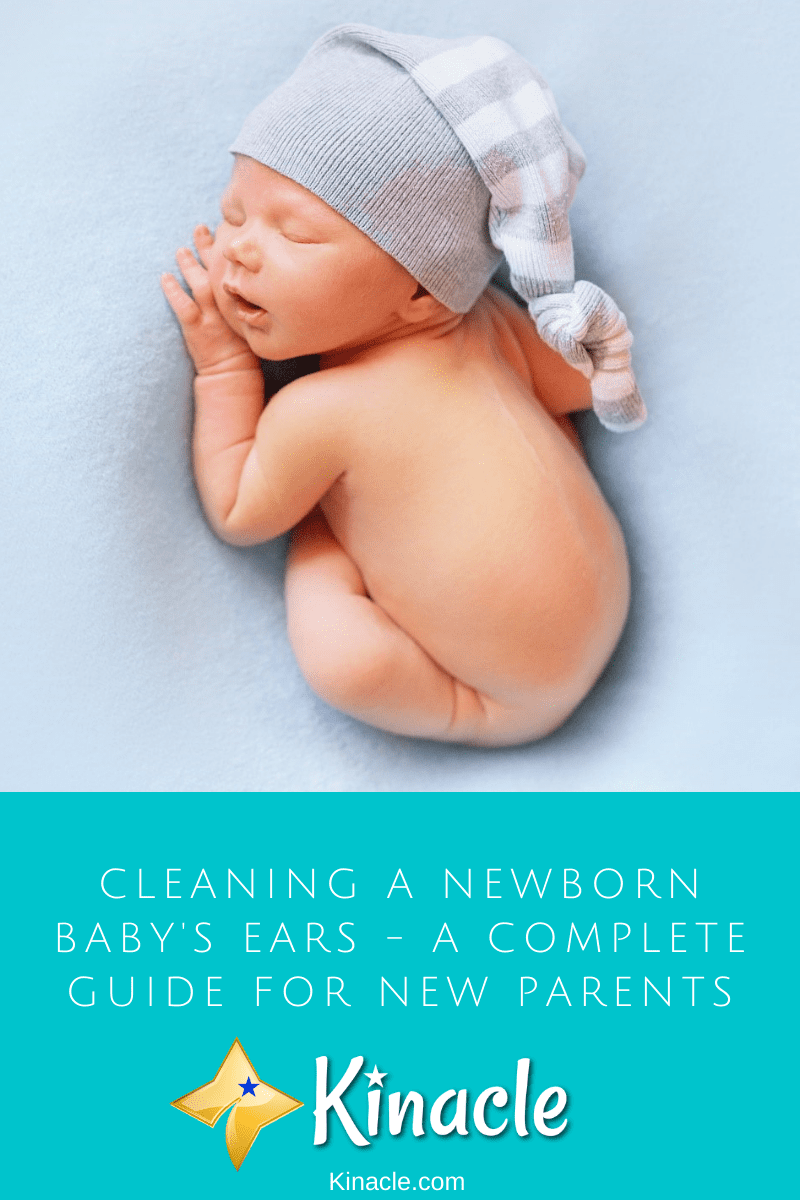
Bringing a newborn baby home is a joyous occasion – but nothing causes more anxiety than cleaning a newborn’s small, sensitive ears for the first time! Read on for tips, do’s and don’ts for cleaning your newborn’s ears.
As unique as parenting is for all moms and dads, many new parents still often share the same experiences. From the pains of labor to the joy of holding their baby for the first time, parenthood does feel like being part of an exclusive club.
And speaking of which…

There are so many new and amazing firsts that you can enjoy now that you’re certified new parent and we’re here to help make the journey easier for you – especially when it comes to cleaning your newborn’s tiny and delicate parts.
One thing that new parents commonly agree on is the anxiety-causing thought of bathing and cleaning their newborn baby for the first time at home and usually without any assistance from anyone more experienced.
Even when nurses in the hospital repeated instructions clearly and carefully, making sure a newborn is clean is still a new experience that many new parents do not feel too confident in. Some might put it off until their in-laws or other family members arrive to help with the baby, or some might feel up to the task only if one parent is around for “moral support” but, as scary as it might feel, keeping our newborns bathed and cleaned regularly is important for keeping our little ones healthy and it should never be put off.
One of the main reasons for a parent’s anxiety over bathing and cleaning their newborn has a lot to do with a newborn baby’s fragility. So small and tiny, skin so soft, with a neck that can’t even support their delicate head completely and their head itself not completely formed, as well – everything about a newborn demands special care and attention, most especially their tiny, sensitive ears.
A frequently asked question and a common concern among many new moms and dads, we’ve created a short yet comprehensive guide for parents to refer to when it’s time to clean baby’s ears.
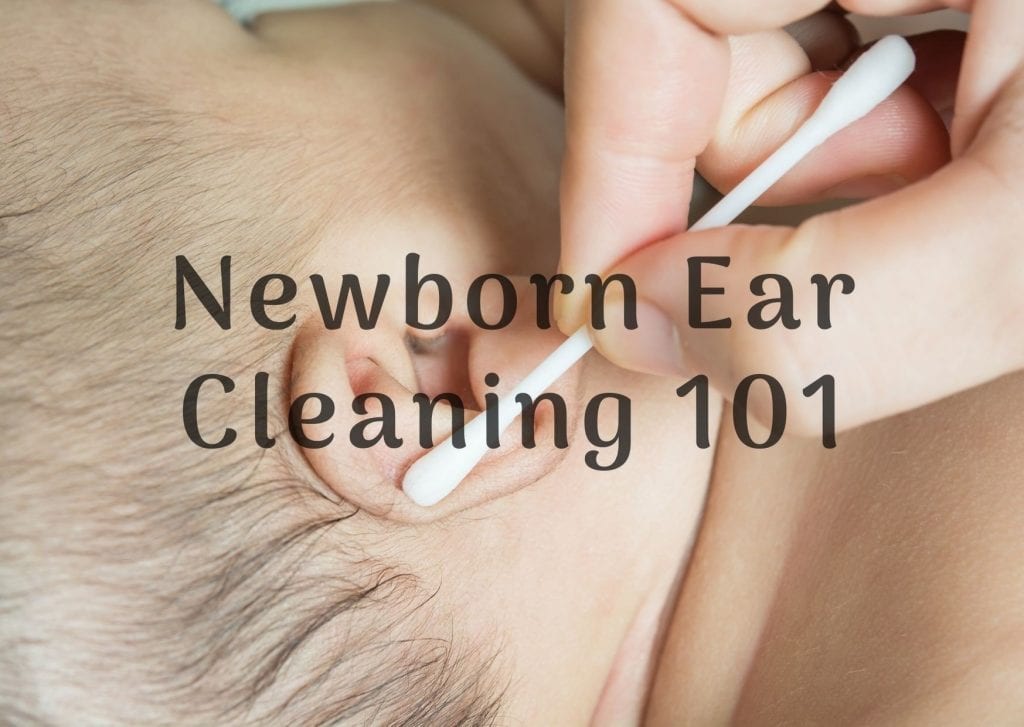
First, the facts. Here’s a rundown of newborn ears and hearing facts that new parents might find useful:
- A newborn’s middle ear is filled with fluid that is usually pushed out as the baby moves outwards through the birth canal. Sometimes, the fluid isn’t always successfully pushed out. If this happens, this is a common cause for a newborn to fail a newborn hearing screening test. Usually, the fluid flushes out by itself within 4-6 months from birth; if it doesn’t, draining the fluid may be necessary.
- Since a newborn’s ears aren’t fully mature yet, they react better to loud, exaggerated, high-pitched sounds and noises or familiar sounds of parents and family members.
- Inside your tummy, your baby started hearing sounds at 23 weeks – from the internal sounds of your body like your heartbeat and the gurgle of your digestive system to your familiar voice and other members of the family. By 35 weeks, the ears are completely formed but after birth, it will still continue to develop.
- A newborn’s response to noise and other sounds can also be based on their temperament and personality e.g. a calmer baby might just have a mild reaction to loud noises while a more sensitive baby might react to every little noise.
- Hearing screening tests are usually given to babies before released from the hospital. For home births or births other than the hospital, it’s recommended that a hearing screening test is given within a baby’s first month to determine any hearing loss or hearing defects as early as possible. The earlier hearing issues are detected, the better it is to find treatment.
- According to the American Speech-Language-Hearing Association or the ASHA, “hearing loss is the most common birth defect among newborns.”
- According to 2011 Centers for Disease Control or CDC statistics, “1.6 percent of babies screened for hearing loss did not pass. Of those who did not pass, 8.6 percent were diagnosed with hearing loss in one or both ears.”
- Amazingly, babies learn to recognize the voice of their mother among all other voices, sounds and noises that they hear. This is because they learn it early from the womb.
- Hearing isn’t just for your newborn to recognize sounds, well-developed hearing is important for learning, language and brain development, as well.
Based on the facts above, it’s safe to say that a newborn’s ears and hearing are important for their growth and development, it’s essential for new parents to know how to clean them. If cleaned incorrectly, your newborn’s hearing might suffer later on.
To start with, let’s talk about a big DON’T:
Don’t use Cotton Swabs / Q-Tips to clean your baby’s inner ear!

Even the small, tiny ones that are meant for babies aren’t recommended. If you’ve already started cleaning the inside of your newborn’s ear with these then it’s time to stop.
But hold on, what’s in an ear, anyway?
To understand why cotton swabs aren’t advisable for cleaning your baby’s ear and to also see the importance of keeping your newborn’s ear healthy, let’s first take a look at how the main parts of the ear and how they all work together.
Divided into three main parts, the ears in itself contain intricate and delicate components that allow babies to hear:
1. The Outer Ear is the part of the ear that we can actually see. In medical terms, it’s called the pinna. By definition, it is the fleshy external part of our ear that is made out of cartilage. The outer ear also includes the ear canal inside that leads into the eardrum. Its job is to direct sound into the middle ear.
When we talk about cleaning your newborn’s ears, we’re referring to your baby’s pinna including the ear canal and when people refer to the “ear” in general, we’re simply talking about the outer ear itself.
The eardrum is what separates the ear canal from the middle ear.
2. The Middle Ear is bit too complicated for us non-medical experts to explain as it contains several parts and components. We’ll take the definition directly from Wikipedia:
“The middle ear includes the tympanic cavity and the three ossicles. The inner ear sits in the bony labyrinth, and contains structures which are key to several senses: the semicircular canals, which enable balance and eye tracking when moving; the utricle and saccule, which enable balance when stationary; and the cochlea, which enables hearing.”
3. The Inner Ear is located deep within the temporal bone and is the most complex part of the ear. In simpler terms, the inner ear has two jobs:
It is responsible for changing sound waves to electrical signals or nerve impulses and it is also responsible for balance. Even while its parts are attached, the inner ear works separately to do each job.
Much like the rest of your newborn baby’s body, their ears are composed of a myriad of parts that are vital to their proper growth and development. And because of their tender age and the fact that their ears are still fine-tuning and maturing, it’s all the more important to protect their ears right after birth.
And by not using a Q-Tip or cotton swab – that’s precisely what you are doing, you are protecting your newborns’ ears.
Why do most parents use a cotton swab to clean inside their baby’s ears?
The reason why mom and dad might reach out for a cotton swab to clean their newborn’s ear is probably due to fear of excessive earwax or earwax buildup.
Parents might feel that since their newborn is so small and tiny, they might think that cleaning their ears with a cotton swab is a precaution to earwax building up.
This is a common worry especially after bathing newborns since new parents feel that there could be just a bit of water trapped in the ear and they don’t want to let it develop into an infection. Cleaning with a cotton swab just inside the ear canal might give new parents a false sense of security and reassurance that they are keeping their tiny newborn as clean as possible.
But statistics show that this isn’t such a great practice, after all.
According to Healthline, “from 1990-2010, ear cleaning was the most common cause for a child in the United States to be omitted to the emergency room for an ear injury. More than 260,000 children were affected. Most commonly, these injuries involve an object stuck in the ear, perforated eardrums, and soft tissue injuries.”
In fact, earwax is healthy! Earwax even has antibacterial properties. Contrary to popular belief, it isn’t actually dirt and it certainly doesn’t mean that you’re not cleaning your newborn’s ears the right way.
Here are some great things about earwax and reasons why you shouldn’t remove them:
- The reason why earwax is thick and a bit sticky is because it provides protection from dirt, dust and other harmful particles that can come inside your baby’s ear.
- To function properly, the skin inside the ear canal must be moisturized. A dry ear canal can cause itchy ears.
- Usually, the ear canal makes the exact amount of earwax needed. Due to this, earwax buildup usually rarely happens.
Your newborn baby’s body is simply amazing! All the little parts work together, even earwax, to make a newborn grow healthy and strong.
When earwax inside the ear does build up, it dries up and just naturally “moves” to your baby’s outer ear. That’s the part that you can see. Sometimes it appears dry and flaky or oily and yellowish, and that’s why parents mistake this for dirt and needs to be removed.
The best thing to do is actually leave the inner ear alone and to leave earwax alone, as well.
In the simplest terms, the ear simply cleans itself. And it produces earwax to help it with self-cleaning.
What actually happens if you clean the inside of your newborns ear with a cotton swab?
If “cleaned” with a cotton swab, your newborn’s natural earwax may be pushed deeper inside – or simply speaking, it may just be pushed towards the parts of the ear that do not need earwax to function and therefore damaging it or causing an infection.
Using a cotton swab to clean inside your newborn’s ear might scratch their sensitive skin, cut the ear canal and irritate the ear itself.
The cotton swab may also remove the natural moisture that your newborn’s ear needs. Dry ears will cause your newborn to become fussy and uncomfortable.
Should your newborn’s ears become irritated or infected, it will be really hard for you to determine. Your poor baby will certainly not be able to tell you what’s wrong and may just generally be crying endlessly or shaking their head from side to side.
What new parents don’t probably know is that any excessive earwax simply falls out by itself, naturally.
 If you feel that any excessive earwax is trapped inside your baby’s ear or if you see pus or blood, please seek medical attention immediately before it causes any infection. You will either be prescribed with ear drops or the earwax will be removed by the doctor using special tools that won’t harm your baby’s ears.
If you feel that any excessive earwax is trapped inside your baby’s ear or if you see pus or blood, please seek medical attention immediately before it causes any infection. You will either be prescribed with ear drops or the earwax will be removed by the doctor using special tools that won’t harm your baby’s ears.
To avoid ear irritation, here’s a step-by-step guide on how clean your newborn baby’s ears safely:

A few guidelines to follow:
- You do not need to clean your newborn’s ears every day but cleaning regularly helps keep your newborn’s ears clean and healthy but over-cleaning every single day might just cause their ears to become dry and itchy. Health experts advise to clean your newborn’s ears 2 to 3 times a week.
- It’s best to clean your baby’s ears after a bath as they’re usually more relaxed and whatever dirt on the outer ear has softened and easier to clean.
- Aside from cotton swabs, do not stick anything in your baby’s ear. You may be tempted to just clean the ear with some other cleaning device or even with your own finger but it isn’t advisable. There is an old saying that anything smaller than your elbow should not be stuck inside your baby’s ears.
Safe Ear-Cleaning Steps Using A Washcloth
Step 1:
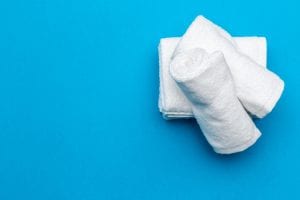
Prepare a soft washcloth rinsed in clean, warm water. Soap is not needed. Make sure to wring the washcloth to remove excess water. Any water droplets might cause earwax buildup.
Step 2:
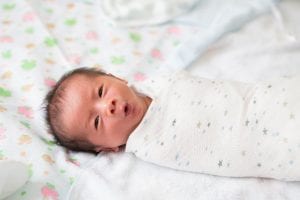
In a room with good, clear lighting, position your baby comfortably either on the bed or changing table, depending it what is most comfortable for you and your baby. Once positioned, gently turn your baby’s head to the side, with the ear turned towards you.
Step 3:

In gentle motions, wipe your baby’s outer ears only with the moist washcloth. Once done, pat dry. And then, you’re done!
Safe Outer Ear-Cleaning Using A Cotton Swab
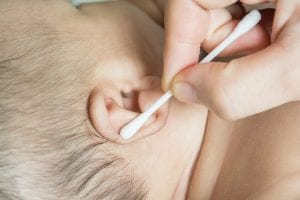
While it’s unsafe to use a cotton swab to clean your baby’s inner ear, you can use a cotton swab to clean your baby’s outer ear.
Using only clean, warm water, dip each tip. Make sure it isn’t overly wet. And then you can use the wet tips of the cotton swab to gently wipe your baby’s outer ear only.
You do not need to use alcohol or baby oil. As mentioned above, the earwax produces its own antibacterial and moisturizing chemicals to keep the ear healthy.
Safe Ear-Cleaning Using Ear Drops
Sometimes, if earwax builds up, your pediatrician might prescribe antibacterial ear drops to soften the earwax which will then encourage it to fall out on its own.
In these cases, we will not be offering any further advice except to follow exactly as your pediatrician instructs.
The only other tip we will give in this regard when using ear drops is to choose a time in your newborn’s day when he is calm and quiet. Ear drops may feel funny and not at all like plain water.
However, there are also natural ways to soften up earwax using a dropper:
- Warm water
- Olive oil
- Baby oil
- Mineral oil
- Coconut oil
The purpose of either antibacterial eardrops or natural eardrops is to simply soften the excess earwax. Should it naturally fall out, it’s still best to wipe gently with a clean, moist washcloth and not to fish it out with cotton swabs or other ear-cleaning tools.
If you wish to use natural methods of softening up earwax build-up, please always consult with your doctor before trying anything.
Conclusion
Fragile and sensitive, cleaning a newborn baby’s ears definitely takes time and patience. And while new parents might be nervous now, but in time, however, parents will gain confidence and the anxiety will be but a funny memory to look back to.
Did you have any challenges in regards to cleaning your baby’s ears? Do you have any special tips to share? Leave it at the comments section below or email us!
Disclaimer:
This article is for informational purposes only and should not be considered medical advice. Always consult with a doctor or licensed medical professional before making any medical decisions.
Leave a Reply